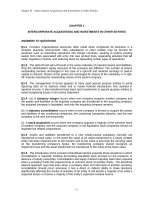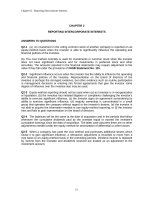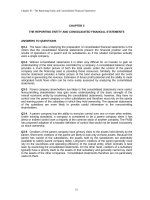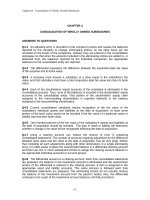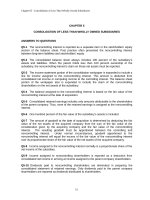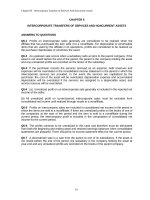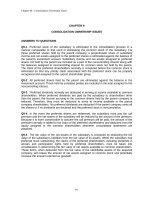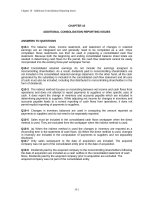Solution manual advanced financial accounting, 8th edition by baker chap009
Bạn đang xem bản rút gọn của tài liệu. Xem và tải ngay bản đầy đủ của tài liệu tại đây (170.3 KB, 43 trang )
Chapter 09 - Consolidation Ownership Issues
CHAPTER 9
CONSOLIDATION OWNERSHIP ISSUES
ANSWERS TO QUESTIONS
Q9-1 Preferred stock of the subsidiary is eliminated in the consolidation process in a
manner comparable to that used in eliminating the common stock of the subsidiary. For
those preferred shares held by the parent company, a proportionate share of subsidiary
income and net assets assigned to the preferred shares is eliminated against the balance in
the parent's investment account. Subsidiary income and net assets assigned to preferred
shares not held by the parent are included as a part of the noncontrolling interest along with
the balances assigned to noncontrolling interest for common stock not held by the parent.
The claim of the preferred shareholders normally is computed before the common stock is
eliminated so that any priority claim associated with the preferred stock can be properly
recognized and assigned to the correct shareholder group.
Q9-2 All preferred shares held by the parent are eliminated against the balance in the
investment account. Those held by unrelated parties are included in the total assigned to the
noncontrolling interest.
Q9-3 Preferred dividends normally are deducted in arriving at income available to common
shareholders. When preferred dividends are paid by the subsidiary to shareholders other
than the parent, the income accruing to the common shares held by the parent company is
reduced. Therefore, they must be deducted to arrive at income available to the parent
company shareholders. No preferred dividends are deducted if the parent company owns all
the shares or if no dividends are declared and the preferred stock is noncumulative.
Q9-4 In the event the preferred shares are redeemed, the subsidiary must pay the call
premium and the net assets of the subsidiary will be reduced by the amount of the premium.
Because it is more conservative to assume the call premium will be paid, the amount of the
premium normally is added to the claim of the preferred shareholders and deducted from the
equity assigned to the common shareholders whenever consolidated statements are
prepared.
Q9-5 The fair value of the net assets of the subsidiary is computed by deducting the fair
value of the subsidiary's liabilities from the fair value of its assets. When the subsidiary has
preferred stock outstanding, the claims of the preferred shareholders, including dividends in
arrears and participation rights held by preferred shareholders, must be taken into
consideration in determining the fair value of net assets available to common shareholders.
These items, when deducted from the fair value of the identifiable assets of the acquired
company, will reduce the amount of net assets assigned to common stock and potentially
increase the amount reported as goodwill.
9-1
Chapter 09 - Consolidation Ownership Issues
Q9-6 The parent may record the difference between the carrying value and the sale price
of the shares as either a gain on sale of investment or an adjustment to its additional paid-in
capital. No gain or loss on the sale of subsidiary shares should be reported in the
consolidated statements. If the parent records a gain on the sale, it should be eliminated in
the consolidation process and treated as a part of additional paid-in capital of the
consolidated entity.
Q9-7 All common shareholders should share equally in the net assets of a company. When
a subsidiary sells additional shares to a nonaffiliate at a price in excess of existing book
value, the effect will be to increase the net book value of all shareholders. Because it is a
capital transaction, no gain or loss is recognized on the sale.
Q9-8 Each purchase of additional shares should be examined to determine the difference
between the price paid and underlying book value. When an amount greater than book value
is paid directly to the subsidiary for the shares, the book value of the shares held by the
noncontrolling interest will increase. As a result, the increase in the parent’s claim on the net
assets of the subsidiary will be less than the amount paid. When consolidated statements
are prepared, additional paid-in capital or retained earnings (if the parent has no additional
paid-in capital) must be debited for the increase in the balance assigned to the
noncontrolling interest, thereby reducing the amount reported in the consolidated balance
sheet.
Q9-9 All the shares of the subsidiary are eliminated in preparing the consolidated
statements. Thus, treasury shares reported by the subsidiary are eliminated in the
consolidation workpaper. The effect of the retirement on the consolidated statements
depends on the price paid and whether the shares were purchased from the parent or from a
nonaffiliate.
Q9-10 Indirect ownership is a general term used whenever one company owns shares of
another company and that company holds ownership in a third company. Indirect control
occurs when a majority of the shares of a particular company are held by one or more
companies that are, in turn, under the control of another company. By exercising its control
over those companies the parent can exercise control of the company indirectly owned.
Q9-11 A reciprocal relationship exists if Subsidiary A and Subsidiary B hold ownership in
each other. If Subsidiary A records investment income based on the reported net income of
Subsidiary B and Subsidiary B records investment income based on the reported net income
of Subsidiary A, the sum of the reported net income totals for the two companies may be
substantially greater than the sum of the reported operating income totals for the two
companies. Parent company net income will be overstated if the impact of the reciprocal
relationship is ignored when the parent company records investment income on its
ownership in the two subsidiaries.
Q9-12 Under the treasury stock method the parent company shares that have been
purchased by a subsidiary are reported as treasury stock in the consolidated balance sheet.
The carrying value of the shares is the amount paid by the subsidiary when they were
purchased.
9-2
Chapter 09 - Consolidation Ownership Issues
Q9-13 Consolidated net income will be reduced by $100,000. Income assigned to the
controlling interest will be reduced by $72,000 ($100,000 x .90 x .80) when the unrealized
profit of Tiny Corporation is eliminated. A total of $10,000 is treated as a reduction to the
income assigned to noncontrolling shareholders of Tiny Corporation ($100,000 x .10) and
$18,000 is a reduction of the income assigned to noncontrolling shareholders of Subsidiary
Company ($100,000 x .90 x .20).
Q9-14 All three companies should be included in the consolidated financial statements.
Slide Company should be consolidated with Bit Company because Bit holds majority
ownership of Slide. Bit Company, in turn, should be consolidated with Snapper Corporation
because Snapper holds majority ownership of Bit.
Q9-15 A subsidiary's stock dividend results in the capitalization of some portion of its
retained earnings. Such an action will have no effect on the consolidated financial
statements since the entire stockholders' equity section of the subsidiary is eliminated in
preparing the consolidation workpaper.
Q9-16 A 15 percent stock dividend is a small stock dividend and must be recorded by
capitalizing retained earnings equal to the market price per share of the stock times the
number of shares actually issued. As a result, retained earnings will decrease and the par
value of stock outstanding and additional paid-in capital will increase on the subsidiary's
books. There should be no change in the investment account balance reported by the
parent. Thus, the only change in the eliminating entries is the relative amount debited to
each of the three individual stockholders' equity accounts of the subsidiary.
Q9-17 When the parent or other affiliates own all the shares of all companies included in the
consolidation, the order in which the consolidation is completed may not be particularly
critical. On the other hand, when less than 100 percent ownership is held there is a much
greater chance of error in apportioning unrealized profits or other adjustments between
noncontrolling ownership and consolidated net income when some other sequence is used.
By starting the consolidation with the company furthest away from the parent, the
computation of income assigned to noncontrolling interest at each level can be most easily
accomplished.
9-3
Chapter 09 - Consolidation Ownership Issues
SOLUTIONS TO CASES
C9-1 Effect of Subsidiary Preferred Stock
When a parent company does not own all the shares of a subsidiary, income assigned to the
noncontrolling interest includes (1) a portion of subsidiary preferred dividends and (2) a
portion of earnings available to common shareholders.
To determine the amount of income to assign to preferred and common shareholders of the
subsidiary, the controller needs to have the following information about the preferred stock:
1. The number of preferred shares outstanding and the number owned by the parent and
other affiliates.
2. The annual preferred dividend rate per share and whether the dividends are cumulative
or noncumulative.
3. If the dividends are noncumulative, the amount of preferred dividends declared during the
period, if any.
In this particular case the parent does not appear to own any of the subsidiary's preferred
shares. Once the controller determines the portion of subsidiary income assignable to
common shareholders, consolidated net income attributable to the controlling interest is
computed by adding the parent's pro rata share of this amount to the parent's income from
its own operations.
C9-2 Consolidated Stockholders’ Equity: Theory vs. Practice
a. Upon the sale of stock of a subsidiary, Xerox used to recognize a gain or loss in the
consolidated income statement equal to the company’s proportionate share of the
corresponding increase or decrease in that subsidiary’s equity. Under FASB 160, the sale of
subsidiary shares is viewed as an equity transaction and does not affect income. Instead,
the difference between the fair value of the consideration received and the change in the
amount of the noncontrolling interest is recognized as an adjustment to stockholders’ equity
(usually additional paid-in capital).
b. Occidental Petroleum has generally treated subsidiary preferred stock as a liability (the
amount is small). It should be reported as part of the noncontrolling interest.
9-4
Chapter 09 - Consolidation Ownership Issues
C9-3 Sale of Subsidiary Shares
MEMO
To:
Robert Reader
Vice President of Finance
Book Corporation
From:
Re:
, CPA
Recognition of Gain on Sale of Subsidiary Shares
Previous accounting standards did not specifically address the issue of how to treat a sale of
subsidiary shares when the parent retained controlling ownership. However, a common
practice was to recognize a gain or loss on the sale of shares.
The FASB’s recent issuance of FASB 160 makes clear that, from a consolidated
perspective, a parent’s sale of subsidiary shares while maintaining control is an equity
transaction. Accordingly, no gain or loss on the sale should be reported in the consolidated
income statement. Instead, equity should be adjusted by the difference between the
consideration received and the change in the parent’s subsidiary interest.
In the current situation, Book’s interest in Lance prior to its sale of Lance shares was
$360,000, an amount equal to 90 percent of Lance’s $400,000 book value. Immediately
following the sale of Lance shares, Book’s remaining 60 percent interest in Lance is
$240,000 ($400,000 x .60), a decrease of $120,000 ($360,000 - $240,000). The difference
between the proceeds received and the change in the book value of Book’s interest in Lance
is as follows:
Proceeds received ($5.60 x 30,000 shares)
Change in book value of interest ($360,000 - $240,000)
Required adjustment to equity
$168,000
120,000
$ 48,000
This $48,000 difference should be reported within equity in the consolidated balance sheet.
Although alternatives exist in terms of how to meet the FASB’s reporting requirement, the
following entry to record the sale of shares on Book’s books would be consistent with the
FASB’s requirement and probably the most efficient approach:
Cash
Investment in Lance Company Stock
Additional Paid-In Capital
168,000
120,000
48,000
The additional paid-in capital recorded on Book’s books would carry over to the consolidated
balance sheet and would be included in consolidated equity.
If Book elected to record a $48,000 gain on the sale of Lance shares instead of recognizing
additional paid-in capital as shown in the entry, that gain would have to be transferred to
additional paid-in capital in the preparation of consolidated financial statements.
Primary citation:
FASB 160
ARB 51 (as amended by FASB 160), Par. 33.
9-5
Chapter 09 - Consolidation Ownership Issues
9-6
Chapter 09 - Consolidation Ownership Issues
C9-4 Sale of Subsidiary Shares
(a) With a sale of shares to a nonaffiliate, net resources have been brought into the
consolidated entity and the noncontrolling shareholders have an additional claim. The
excess of the proceeds received from the sale over the change in the parent’s interest in the
subsidiary increases the amount of additional paid-in capital reported in the consolidated
balance sheet. A sale of subsidiary shares to a nonaffiliate also changes the amount of
income assigned to the noncontrolling interest in the consolidated income statement and the
amount of net assets assigned to the noncontrolling interest in the consolidated balance
sheet.
(b) When a parent sells shares of one subsidiary to another subsidiary, net resources to the
consolidated entity do not change. Any gain recorded by the parent must be eliminated when
the investment balance reported by the subsidiary is eliminated in preparing consolidated
financial statements. A change in the claim of the noncontrolling interest is likely to occur if
the subsidiary that purchases the shares is not wholly owned. As a result, there may be
some change in consolidated income and the balance sheet totals assigned to
noncontrolling interest.
C9-5 Reciprocal Ownership
A great many factors beyond the immediate impact on reported earnings may be important
in deciding on the use of the funds. Items such as the following should be considered:
1. Are the excess funds held by Thorson available only temporarily or are they not likely to
be needed in the foreseeable future?
2. Will there be any regulatory or taxation problems associated with one or more of the
alternatives?
3. Can shares of the companies be purchased in the desired quantities and at existing
market prices or are there potential difficulties associated with one or more alternatives?
4. Is it desirable to acquire more shares of either subsidiary since controlling ownership
already is in the hands of Strong Manufacturing?
5. Have the noncontrolling shareholders of either subsidiary been troublesome or caused
the parent to refrain from actions that it might otherwise have taken?
With the information given, it is difficult to determine which action will have the most
favorable impact on consolidated net income. The earnings of each company, the number of
shares outstanding, and the relative market prices of the shares each will have an effect. In
general, reported income is maximized by purchasing the shares with the lowest priceearnings ratio.
9-7
Chapter 09 - Consolidation Ownership Issues
SOLUTIONS TO EXERCISES
E9-1 Multiple-Choice Questions on Preferred Stock Ownership
1.
d
$50,000 = $20,000 + $30,000
2.
c
$29,000 = $20,000 + .30($30,000)
3.
b
Only the retained earnings of the acquiring company is included.
4.
a
The portion held by the parent is eliminated when the preferred investment is
eliminated, and the portion held by nonaffiliates is eliminated and included with the
balance reported as noncontrolling interest in the consolidated balance sheet.
E9-2 Multiple-Choice Questions on Multilevel Ownership
1.
b
$188,000 = $100,000 + .80[$80,000 + .60($50,000)]
2.
b
$20,000 = .40($50,000)
3.
c
$22,000 = .20[$80,000 + .60($50,000)]
4.
c
$42,000 = .40($50,000) + .20[$80,000 + .60($50,000)]
5.
b
$2,400 = .80 x .60[($150,000 + $100,000 - $200,000) / 10 years)
E9-3 Acquisition of Preferred Shares
Eliminating entries:
E(1)
E(2)
Common Stock — Separate Company
Retained Earnings
Investment in Separate Company Common
Stock
Noncontrolling Interest
Eliminate investment in common stock.
50,000
150,000
Preferred Stock — Separate Company
Investment in Separate Company
Preferred Stock
Noncontrolling Interest
Eliminate subsidiary preferred stock.
100,000
9-8
140,000
60,000
60,000
40,000
Chapter 09 - Consolidation Ownership Issues
E9-4 Reciprocal Ownership [AICPA Adapted]
a.
None of Simba's dividends is reported in the consolidated statements. All of Simba's
dividends are eliminated in the consolidation process.
b.
Only 90 percent of Pride's dividends are included in the consolidated retained
earnings statement. The dividend payment on the 10 percent owned by Simba is an
intercorporate payment to an affiliate and must be eliminated in the consolidation
process.
E9-5 Subsidiary with Preferred Stock Outstanding
Eliminating entries:
E(1)
E(2)
Common Stock — Topple Company
Retained Earnings
Investment in Topple Common Stock
Noncontrolling Interest
Eliminate investment in common stock.
150,000
210,000
Preferred Stock — Topple Company
Investment in Topple Preferred Stock
Noncontrolling Interest
Eliminate subsidiary preferred stock.
200,000
270,000
90,000
80,000
120,000
E9-6 Subsidiary with Preferred Stock Outstanding
a.
Entries recorded by Clayton Corporation:
(1)
Investment in Topple Common Stock
Investment in Topple Preferred Stock
Cash
Record purchase of Topple stock.
270,000
80,000
(2)
Cash
Investment in Topple Common Stock
Record dividends from Topple:
$25,500 = ($50,000 - $16,000) x .75
(3)
Cash
Dividend Income
Record dividends on preferred stock
from Topple: $16,000 x .40
6,400
(4)
Investment in Topple Common Stock
Income from Subsidiary
Record equity-method income:
$40,500 = ($70,000 - $16,000) x .75
40,500
9-9
25,500
350,000
25,500
6,400
40,500
Chapter 09 - Consolidation Ownership Issues
E9-6 (continued)
b.
Eliminating entries:
E(1)
Income from Subsidiary
Dividends Declared — Common Stock
Investment in Topple Common Stock
Eliminate income from subsidiary.
E(2)
Dividend Income — Preferred
Dividends Declared — Preferred
Eliminate dividend income from
subsidiary preferred.
E(3)
Income to Noncontrolling Interest
Dividends Declared — Preferred Stock
Dividends Declared — Common Stock
Noncontrolling Interest
Assign income to noncontrolling interest:
$23,100 = [($70,000 - $16,000) x .25] +
($16,000 x .60)
$9,600 = $16,000 x .60
$8,500 = ($50,000 - $16,000) x .25
$5,000 = $13,500 - $8,500
23,100
E(4)
Common Stock — Topple Company
Retained Earnings, January 1
Investment in Topple Common Stock
Noncontrolling Interest
Eliminate beginning investment balance.
150,000
210,000
Preferred Stock — Topple Company
Investment in Topple Preferred Stock
Noncontrolling Interest
Eliminate subsidiary preferred stock.
200,000
E(5)
9-10
40,500
6,400
25,500
15,000
6,400
9,600
8,500
5,000
270,000
90,000
80,000
120,000
Chapter 09 - Consolidation Ownership Issues
E9-7 Preferred Dividends and Call Premium
a.
Culbertson Company's contribution to 20X2 consolidated net income is equal to
its reported net income of $70,000.
b.
Income assigned to noncontrolling interest:
Preferred shares [.40($100,000 x .12)]
Common shares {.10[$70,000 - ($100,000 x .12)]}
Total income assigned to noncontrolling interest
c.
$ 4,800
5,800
$10,600
Retained earnings assignable to preferred shareholders:
Dividends in arrears [5 years x ($100,000 x .12)]
Call feature ($2 x 10,000 shares)
Total retained earnings assigned to preferred stock
d.
Book value of common shares:
Par value of common shares outstanding
Retained earnings balance
Less: Balance assigned to preferred shares
Book value of common shares
e.
$60,000
20,000
$80,000
$380,000
(80,000)
$300,000
300,000
$600,000
Total noncontrolling interest:
Preferred stock [.40($100,000 + $80,000)]
Common stock (.10 x $600,000)
Total noncontrolling interest
9-11
$
72,000
60,000
$132,000
Chapter 09 - Consolidation Ownership Issues
E9-8 Multilevel Ownership
a.
Consolidated net income for 20X6 is $190,000 ($90,000 + $40,000
+ $60,000)
b.
Income of $36,800 is assigned to the noncontrolling interest:
Income from Dally ($40,000 x .35)
Income from Latent [($60,000 + $16,000) x .30]
Total income assigned to noncontrolling interest
c.
Income of $153,200 is assigned to the controlling interest:
Consolidated net income
Less: Income assigned to noncontrolling interest
Income assigned to controlling interest
d.
$14,000
22,800
$36,800
Only the $45,000 of dividends paid by Grasper Corporation to its
shareholders will be reported as dividends declared in Grasper’s
20X6 consolidated retained earnings statement.
9-12
$190,000
(36,800)
$153,200
Chapter 09 - Consolidation Ownership Issues
E9-9 Eliminating entries for Multilevel Ownership
a.
b.
c.
Journal entries recorded by Brown Corporation on its investment in Tann Company:
(1)
Investment in Tann Company Stock
Cash
Record purchase of Tann Company stock.
(2)
Cash
Investment in Tann Company Stock
Record dividends from Tann Company:
$15,000 x .60
(3)
Investment in Tann Company Stock
Income from Tann Company
Record equity-method income:
$40,000 x .60
120,000
9,000
24,000
120,000
9,000
24,000
Journal entries recorded by Promise Enterprises on its investment in Brown
Corporation:
(1)
Investment in Brown Corporation Stock
Cash
Record purchase of Brown Corporation
stock.
(2)
Cash
Investment in Brown Corporation Stock
Record dividends from Brown Corporation:
$50,000 x .90
(3)
Investment in Brown Corporation Stock
Income from Brown Corporation
Record equity-method income:
($120,000 + $24,000) x .90
315,000
45,000
129,600
315,000
45,000
129,600
Eliminating entries:
E(1)
Income from Tann Company
Dividends Declared
Investment in Tann Company Stock
Eliminate income from Tann Company.
24,000
E(2)
Income to Noncontrolling Interest
Dividends Declared
Noncontrolling Interest
Assign income to noncontrolling interest:
$16,000 = $40,000 x .40
$6,000 = $15,000 x .40
16,000
9-13
9,000
15,000
6,000
10,000
Chapter 09 - Consolidation Ownership Issues
E9-9 (continued)
E(3)
Common Stock — Tann Company
Additional Paid-In Capital
Retained Earnings, January 1
Investment in Tann Company Stock
Noncontrolling Interest
Eliminate investment in Tann Company
stock:
$120,000 = $200,000 x .60
$80,000 = $200,000 x .40
100,000
60,000
40,000
E(4)
Income from Brown Corporation
Dividends Declared
Investment in Brown Corporation Stock
Eliminate income from Brown Corporation.
129,600
E(5)
Income to Noncontrolling Interest
Dividends Declared
Noncontrolling Interest
Assign income to noncontrolling
shareholders of Brown Corporation:
$14,400 = ($120,000 + $24,000) x .10
$5,000 = $50,000 x .10
$9,400 = $14,400 - $5,000
E(6)
Common Stock — Brown Corporation
Additional Paid-In Capital
Retained Earnings, January 1
Investment in Brown Corporation Stock
Noncontrolling Interest
Eliminate investment in Brown
Corporation stock:
$315,000 = $350,000 x .90
$35,000 = $350,000 x .10
9-14
14,400
150,000
60,000
140,000
120,000
80,000
45,000
84,600
5,000
9,400
315,000
35,000
Chapter 09 - Consolidation Ownership Issues
E9-10 Reciprocal Ownership
Operating income of Grower Supply Corporation
Operating income of Schultz Company
Consolidated net income
Less: Income to noncontrolling interest:
($50,000 x .15)
Income to controlling interest
9-15
$112,000
50,000
$162,000
(7,500)
$154,500
Chapter 09 - Consolidation Ownership Issues
E9-11 Consolidated Balance Sheet with Reciprocal Ownership
Talbott Company and Short Company
Consolidated Balance Sheet Workpaper
December 31, 20X9
Item
Cash
Accounts Receivable
Inventory
Buildings and
Equipment (net)
Investment in Short
Co. Common Stock
Investment in Talbott
Co. Common Stock
Treasury Stock
Debits
Accounts Payable
Bonds Payable
Common Stock
Retained Earnings
Noncontrolling Interest
Credits
Talbott
Company
Short
Company
78,000
120,000
150,000
39,000
80,000
120,000
117,000
200,000
270,000
400,000
300,000
700,000
Eliminations
Credit
352,000
Consolidated
(1)352,000
61,000
(2) 61,000
1,100,000
600,000
90,000
400,000
300,000
310,000
60,000
100,000
200,000
240,000
(1)200,000
(1)240,000
1,100,000
600,000
501,000
Eliminating entries:
E(1)
Common Stock — Short Company
Retained Earnings
Investment in Short Company Common
Stock
Noncontrolling Interest
E(2)
Debit
Treasury Stock
Investment in Talbott Company
Common Stock
9-16
(2) 61,000
(1) 88,000
501,000
61,000
1,348,000
150,000
500,000
300,000
310,000
88,000
1,348,000
200,000
240,000
352,000
88,000
61,000
61,000
Chapter 09 - Consolidation Ownership Issues
E9-11 (continued)
Talbott Company and Subsidiary
Consolidated Balance Sheet
December 31, 20X9
Current Assets:
Cash
Accounts Receivable
Inventory
Noncurrent Assets:
Buildings and Equipment (net)
Total Assets
$117,000
200,000
270,000
$
587,000
700,000
$1,287,000
Current Liabilities:
Accounts Payable
Bonds Payable
Stockholders' Equity:
Controlling Interest:
Common Stock
Retained Earnings
Total Controlling Interest
Noncontrolling Interest
Total Equity before Reduction for Treasury Shares
Less: Treasury Shares
Total Stockholders’ Equity
Total Liabilities and Stockholders' Equity
9-17
$ 150,000
500,000
$300,000
310,000
$610,000
88,000
$698,000
(61,000)
637,000
$1,287,000
Chapter 09 - Consolidation Ownership Issues
E9-12 Subsidiary Stock Dividend
a.
Lake Company:
Stock Dividends Declared
Common Stock
40,000
40,000
Lindale Company: No entry required.
b.
c.
Eliminating entries, December 31, 20X3:
E(1)
Income from Subsidiary
Dividends Declared
Investment in Lake Company Stock
E(2)
Income to Noncontrolling Interest
Dividends Declared
Noncontrolling Interest
E(3)
Common Stock — Lake Company
Retained Earnings, January 1
Investment in Lake Company Stock
Noncontrolling Interest
Stock Dividends Declared
17,500
7,500
140,000
200,000
7,000
10,500
3,000
4,500
210,000
90,000
40,000
Eliminating entry, January 1, 20X4:
E(1)
Common Stock — Lake Company
Retained Earnings
Investment in Lake Company Stock
Noncontrolling Interest
140,000
175,000
Lake Company retained earnings, December 31, 20X3:
Balance, December 31, 20X2
Add: Net income for 20X3
Less: Stock dividend in 20X3
Cash dividend paid in 20X3
Balance, December 31, 20X3
$200,000
25,000
(40,000)
(10,000)
$175,000
9-18
220,500
94,500
Chapter 09 - Consolidation Ownership Issues
E9-13 Sale of Subsidiary Shares by Parent
a.
Investment in Acme Concrete, January 1, 20X5:
Purchase price
Acme net income in 20X3 and 20X4
Dividends paid by Acme in 20X3 and 20X4
Proportion of stock held by Stable
Balance prior to sale of shares
b.
$360,000
48,000
$408,000
Journal entry recorded by Stable Home Builders for sale of shares:
Cash
Investment in Acme Stock
Additional Paid-in Capital
$102,000 = $408,000 x 4,000 /
[($200,000 / $10) x .80]
c.
$100,000
(40,000)
$ 60,000
x
.80
120,000
102,000
18,000
Eliminating entries:
E(1)
Income from Subsidiary
Dividends Declared
Investment in Acme Stock
30,000
E(2)
Income to Noncontrolling Interest
Dividends Declared
Noncontrolling Interest
20,000
E(3)
Common Stock — Acme Concrete
Retained Earnings, January 1
Investment in Acme Stock
Noncontrolling interest
200,000
310,000
12,000
18,000
8,000
12,000
306,000
204,000
E9-14 Purchase of Additional Shares from Nonaffiliate
a.
Purchase price, December 31, 20X7
Modern Products Company net income for 20X8
($230,000 + $20,000 - $200,000)
Proportion of stock held by Weal
Income from subsidiary
Dividend received from Modern Products Company
($20,000 x .60)
Balance in investment account, December 31, 20X8
9-19
$210,000
$50,000
x
.60
30,000
(12,000)
$228,000
Chapter 09 - Consolidation Ownership Issues
9-20
Chapter 09 - Consolidation Ownership Issues
E9-14 (continued)
b.
Balance in investment account, December 31, 20X8
Purchase of additional shares on January 1, 20X9
Investment balance January 1, 20X9, after purchase
Modern Products Company net income for 20X9
($280,000 + $20,000 - $230,000)
Proportion of stock held by Weal
Less: Amortization of differential on stock
purchased January 1, 20X9: ($20,000 / 10 years)
Income from subsidiary
Dividend received from Modern Products
Company ($20,000 x .80)
Balance in investment account, December 31, 20X9
c.
$228,000
96,000
$324,000
$70,000
x
.80
$56,000
(2,000)
54,000
(16,000)
$362,000
Eliminating entries:
E(1)
Income from Modern Products Company
Dividends Declared
Investment in Modern Products
Company Stock
Eliminate income from subsidiary.
54,000
E(2)
Income to Noncontrolling Interest
Dividends Declared
Noncontrolling Interest
Assign income to noncontrolling interest:
$14,000 = $70,000 x .20
14,000
E(3)
Common Stock — Modern Products Company
Retained Earnings, January 1
Differential
Investment in Modern Products
Company Stock
Noncontrolling Interest
Eliminate beginning investment balance:
$20,000 = $96,000 – ($380,000 x .20)
$76,000 = $380,000 x .20
E(4)
Patents
Amortization Expense
Differential
Assign differential and amortize for year:
$2,000 = $20,000 / 10 years
9-21
16,000
38,000
4,000
10,000
150,000
230,000
20,000
324,000
76,000
18,000
2,000
20,000
Chapter 09 - Consolidation Ownership Issues
E9-15 Repurchase of Shares by Subsidiary from Nonaffiliate
a.
Book value of Quinn stock outstanding
Cost of treasury shares repurchased
Book value of remaining shares outstanding
Proportion of remaining shares held by noncontrolling
Interest (2,000 / 8,000)
Adjusted book value of shares held
Book value of shares held before treasury stock
repurchase by Quinn ($500,000 x .20)
Reduction of noncontrolling interest
Consideration given by Quinn Manufacturing
Increase in equity attributable to parent
$500,000
(84,000)
$416,000
x
.25
$104,000
(200,000)
$ 96,000
(84,000)
$ 12,000
b.
Investment in Quinn Manufacturing Stock
Additional Paid-In Capital
12,000
c.
Common Stock — Quinn Manufacturing
Additional Paid-In Capital
Retained Earnings, January 1
Investment in Quinn Stock
Noncontrolling Interest
Treasury Shares
$312,000 = .75($500,000 - $84,000)
$104,000 = .25($500,000 - $84,000)
100,000
150,000
250,000
9-22
12,000
312,000
104,000
84,000
Chapter 09 - Consolidation Ownership Issues
E9-16 Sale of Shares by Subsidiary to Nonaffiliate
a.
Computation of change in book value of Schroeder Corporation shares held by
Browne Corporation:
Common stock, $10 par value
Additional paid-in capital
Retained earnings
Total stockholders' equity of Schroeder
Proportion of stock held by Browne
Corporation:
11,000 / 15,000
11,000 / (15,000 + 5,000)
Book value of shares
Before
Sale
After
Sale
$150,000
50,000
400,000
$600,000
$ 200,000
400,000
400,000
$1,000,000
x
.733
$440,000
Increase in book value of shares held by
Browne Corporation
$ 110,000
b.
Investment in Schroeder Stock
Additional Paid-In Capital
110,000
c.
Common Stock — Schroeder Corporation
Additional Paid-In Capital
Retained Earnings
Investment in Schroeder Stock
Noncontrolling Interest
$450,000 = $1,000,000 x .45
200,000
400,000
400,000
9-23
x
.550
$ 550,000
110,000
550,000
450,000
Chapter 09 - Consolidation Ownership Issues
SOLUTIONS TO PROBLEMS
P9-17 Multiple-Choice Questions on Preferred Stock Ownership
1.
d
Book value of shares held by noncontrolling interest:
Preferred stock ($100,000 x .30)
Common stock [($200,000 + $50,000) x .20]
Total book value
2.
b
Income to noncontrolling preferred shareholders
[($100,000 x .10) x .30]
Income to noncontrolling common shareholders:
Reported net income of Upland Company
Income to preferred shareholders
Income to common shareholders
Proportion of common stock owned by
noncontrolling interest
Total income to noncontrolling interest
3.
b
Reported net income of Upland Company
Operating income of Stacey Company
Consolidated net income
Less: Income to noncontrolling interest
Income to controlling interest
4.
c
Controlling interest:
Common stock
Retained earnings
Total controlling interest
Noncontrolling interest: ($250,000 x .20) +
($100,000 x .30)
Total stockholders’ equity
5.
a
$30,000
50,000
$80,000
$3,000
$30,000
(10,000)
$20,000
x
.20
All preferred shares of the subsidiary are eliminated in preparing the
consolidated financial statements.
9-24
4,000
$7,000
$ 30,000
100,000
$130,000
(7,000)
$123,000
$ 300,000
350,000
$ 650,000
80,000
$730,000
Chapter 09 - Consolidation Ownership Issues
P9-18 Multilevel Ownership with Differential
a.
b.
Journal entries recorded by Corn Corporation on its investment in Bark Company:
(1)
Investment in Bark Company Stock
Cash
Record purchase of Bark Company stock.
406,000
(2)
Cash
Investment in Bark Company Stock
Record dividends from Bark Company:
$20,000 x .70
14,000
(3)
Investment in Bark Company Stock
Income from Bark Company
Record equity-method income:
$30,000 x .70
21,000
(4)
Income from Bark Company
Investment in Bark Company Stock
Amortize differential related to
buildings and equipment:
($30,000 / 10 years) x .70
2,100
406,000
14,000
21,000
2,100
Journal entries recorded by Purple Corporation on its investment in Corn
Corporation:
(1)
Cash
Investment in Corn Corporation Stock
Record dividends from Corn Corporation:
$25,000 x .80
20,000
(2)
Investment in Corn Corporation Stock
Income from Corn Corporation
Record equity-method income:
($60,000 + $18,900) x .80
63,120
(3)
Income from Corn Corporation
Investment in Corn Corporation Stock
Amortize differential related to
trademark: ($50,000 / 5 years) x .80
9-25
8,000
20,000
63,120
8,000
